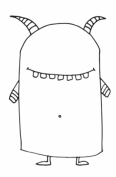
When I was a full-time prevention educator at a crisis center in the rural Midwest, I used to facilitate this “monster” activity with kids in early elementary school classrooms. After a few visits in which I talked about healthy relationships, body boundaries, and respect with the kids, I’d introduce this activity to get them thinking about how to express what makes them scared, how to speak back to what makes them upset, and where they can go for help if they need it. I love the activity because it involves creativity, crayons, and healthy coping skills; they love to color and share their masterpieces.
It goes like this: I ask the kids to think about something that makes them scared, angry, upset, or sad. I hand out coloring sheets with an outline of a monster that they can color however they want based on how they feel. It’s awesome watching them go to work, and even more fun to ask them what they would name their monster, and what sound it would make. They get super into it, and I adore watching them express themselves. When they are finished, I help them talk back to their monsters (they repeat phrases like, “You don’t win, monster!” which is, of course, empowering and fun for them) and we talk about how it’s ok to feel lots of different emotions, how to deal with them in a healthy way, and what to do if someone is hurting them.
A girl in a kindergarten class I visited last year named her picture, “The Love Monster.” Unlike many of the other children who had colored scary or angry monsters, her monster was cute and covered with red and pink hearts. When I asked her why it was called the love monster, she explained that a boy at school was “in love” with her and would not leave her alone. This made her frustrated and angry. I was so struck by the picture that I don’t recall the exact details of this situation, though I know we talked about how if a boy wouldn’t leave her alone it was not ok and that she needed to tell (and keep telling) teachers and other adults about what was happening if he didn’t stop.
The Love Monster stuck with me because I think it suggests some realities about how girls are taught to deal with sexual harassment, abuse, and assault. We are often taught to politely decline or ignore advances, smile through our anger, and minimize potentially violent actions because “boys will be boys.” Many of us, regardless of gender, may grow up mistaking attention for love, and sometimes it becomes difficult for us to differentiate love and respect from abuse and control. When Lady Gaga sings, “That boy is a monster,” I think one thing she’s capturing is the complicated sort of way many of us have become used to being consumed and disrespected by people in our lives. We may even love these individuals, even though we know they are “wolves in disguise.” Even though we may know we deserve more than that.
We need to teach kids (across a continuum of gender) what real care and respect—and love—looks like. We need to teach them what it means to care for and respect and love themselves as well as others. And we all need to learn how to deal with “Love Monsters” in both polite and impolite ways. It is not always easy. I know I am still learning. Perhaps that is why I love that Lady Gaga song so much.

 RSS Feed
RSS Feed